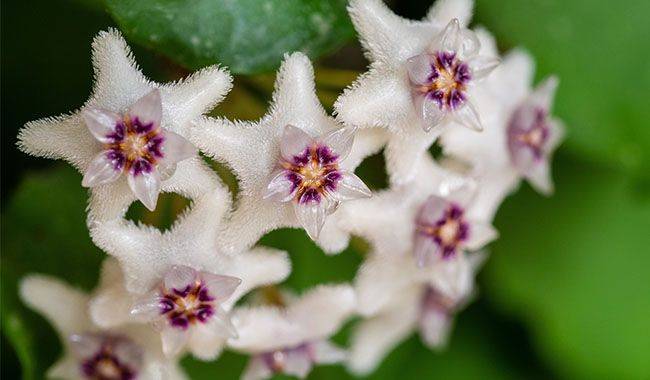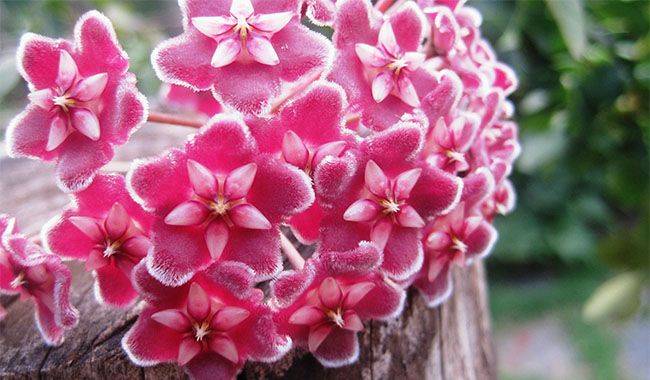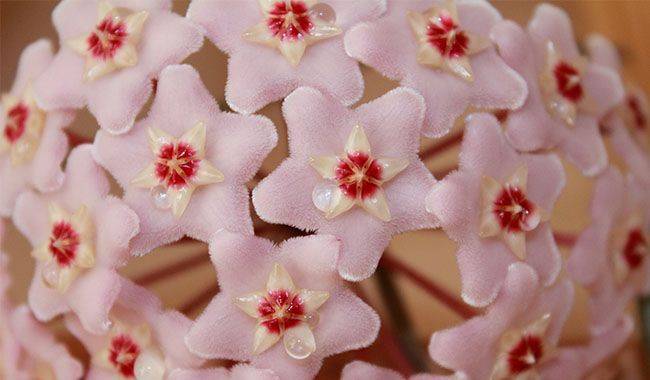
I went to a friend’s house one day and I was struck by the beauty of the white flowers on one of the plants. They looked like delicate toys made by a skilled jeweler – the waxy sheen of the petals and the absolute symmetry.” It was magnificent!” – I marveled. I hadn’t paid much attention to it before because I’d never seen it bloom. Sure enough, I soon found this tropical vine in my collection. But I ran into a problem when I planted it. Some of the leaves first changed color and then started to fall off. I found out why. I will tell you how to grow the Hoya flower and why it sheds its leaves in this ThumbGarden article.
TYPES OF HOYA FLOWER
When I received a new plant from a friend, I started looking for the species it belonged to. The inflorescences I saw helped me make my decision. As it turned out, mine was the most common succulent Hoya flower (Hoya carnosa). I was pleased to find that it was unpretentious and did not require much attention.
It is native to the tropical regions of Sri Lanka, Asia, Polynesia, and the Philippines. It is a succulent, water-accumulating plant that grows in the wild against the trunks of taller plants or trees. It is not parasitic but simply seeks support.
Of the many species found in nature, only a few are rooted as houseplants.
Hoya bella is a very decorative dwarf Hoya flower.
Hoya multiflora has up to 40 flowers per inflorescence and has a lemon scent.
Hoya imperialis – pink flowers hanging from umbels.
Hoya kerrii and like the fleshy Hoya flower, is a very popular species with large, heart-shaped, upside-down leaves.
The conditions for caring for all indoor Hoya species are practically the same. Therefore, my advice will also be helpful for those florists who grow other species besides the Hoya flower.
CONDITIONS AND CARE OF HOYA FLOWER

In the wild, the Hoya flower climbs to high places and clings to tree trunks and branches. In heavy tropical rains, it tries to store life-giving moisture and almost never sees bright sunlight. Understandably, the Hoya flower will require similar conditions from the owner of the apartment in which it is planted.
A. Temperature
It is a heat-loving plant that is comfortable in temperatures of 68-77 °F (20-25°C) year-round. However, the Hoya flower does not decorate best in hot conditions, but in cool conditions-about 68 °F (20°C).
Plants will not have any problems surviving at 59 °F (15 °C) for a few days, but staying in such a room for a long time or cooling the room further will disturb the roots and may lead to death.
B. Lighting
Being in direct sunlight can cause severe burns to the Hoya flower, but it needs good light. Putting it in a southwest or southeast window with some shade, or in the west and east window without a screen, is the best solution for the Hoya flower.
It needs a place where it can live immediately and for a long time. It does not like to be moved, especially during the germination and flowering period. If you disturb it at this time, it will surely drop its leaves, buds, and flowers.
C. Watering and humidifying the air
There are two things to consider when watering: it does not tolerate too much watering and there is a dormant period in winter. in October, after flowering, when the root ball is almost completely dry, watering will be gradually reduced to infrequent watering. From the beginning of March, the frequency and quantity of watering will be increased. However, watering should still be moderate and only after the substrate has dried out.
I have noticed that the Hoya flower can even benefit from an artificial dry period by delaying watering for 2 to 3 days. But not during the formation of buds. I don’t have a strict watering schedule, I just check the condition of the soil. If it has dried out to fingertip length, it’s time to water. You can’t let water pool in the tray because it will cause root rot. I use a regular sponge to remove the excess water.
This vine is very fond of wiping the leaves or taking a hot bath. During this time, the pot must be kept out of the water. I cover it with plastic wrap or after a shower, gently tilt it to pour out the excess water. After this, I do not water the plants for about a week.
D. Fertilizing
In the case of the Hoya flower, you should not over-fertilize with complicated fertilizers. In winter, they are not needed at all. During the flowering period, I water my Hoya flowers with Kemira once a month. Dose in liquid form – half a measuring bottle in 0.5 gals (2 liters) of water, or 0.5 teaspoons of granules in a 0.8 gals (3 liters) jar. Pour off the excess immediately; the solution should only be used within a day.
I’ve heard that these vines adapt well to mineral orchid gel. I haven’t tried it myself; my Hoya flower is still in bloom, so I couldn’t be bothered to experiment. About once every 2 months, I water them with water from the tank. That’s all the nutrition. The succulent Hoya flower doesn’t like to eat too much and will drop its buds and leaves.
E. Transplantation
This is a very important moment. Do it every 2-3 years because the soil is depleted and the root system is growing. This was the mistake I made and the plant paid for it by losing half of its leaves. As it turns out, the Hoya flower should not be watered for about a week after transplanting. And I also chose a pot that was too big. Succulents cannot tolerate any root support.
Luckily, my plants are hardy and a friend told me the reason for the wilting. Instead of replanting, I gave my Hoya flower a “drought period”, spraying it with a natural biostimulant every 14 days to improve the plant’s hardiness and resistance to external factors, and the plant became stronger and regenerated faster. One ampoule is enough for 1.3 gals (5 liters) of water and the solution is only suitable for 48 hours.
When choosing a planting substrate, you must remember that the roots need air, so a drainage layer of fine clay pebbles is essential. For the Hoya flower, I made my own substrate, mixing peat, humus, sand, and garden soil in a ratio of 1:1:1:2, and adding a handful of crushed bark. hoya flower rooted well in the suggested mixture. Next time I will try the substrate for palm trees or orchids.
WHY DOES THE HOYA FLOWER DROP ITS LEAVES

After observing the Hoya flower, I realized that it responds to many factors by shedding green pieces.
- Frequent change of residence.
- Overwatering for a long time.
- Lack of light.
- Depletion of soil.
- Beginning of dormancy period.
- Rotting of the roots.
- The pot is too spacious.
- Wrong soil.
- The appearance of pests.
By the way, the plant can warn you of many problems. For example, the need for watering is indicated by the thin leaves. If they are thick and fleshy, with a wide cross-section, then the plant has stored enough water to postpone watering.
Yellowing and misshapen young leaves and shoots indicate the presence of pests. Root rot can be clearly indicated by fallen leaves and gray patches at the base of the stem near the ground.
Once you find the cause, it is easy to eliminate it and keep the plant healthy. My Hoya flower bloomed in its fourth year. A lovely honey smell wafted out of the flowers and some petals had clear droplets around the edges. Once again I was overwhelmed by the introspective beauty of this plant.
Only now do I have to air out the room more often. I moved the pot from my bedroom to the living room because of its strong scent. Fortunately, these rooms are all on the same southeast side, so this move went unnoticed by the plant.
My Hoya flower is now healthy and full of vigor, with all the leaves in place and not falling off, and I sincerely hope the same for your vine.







